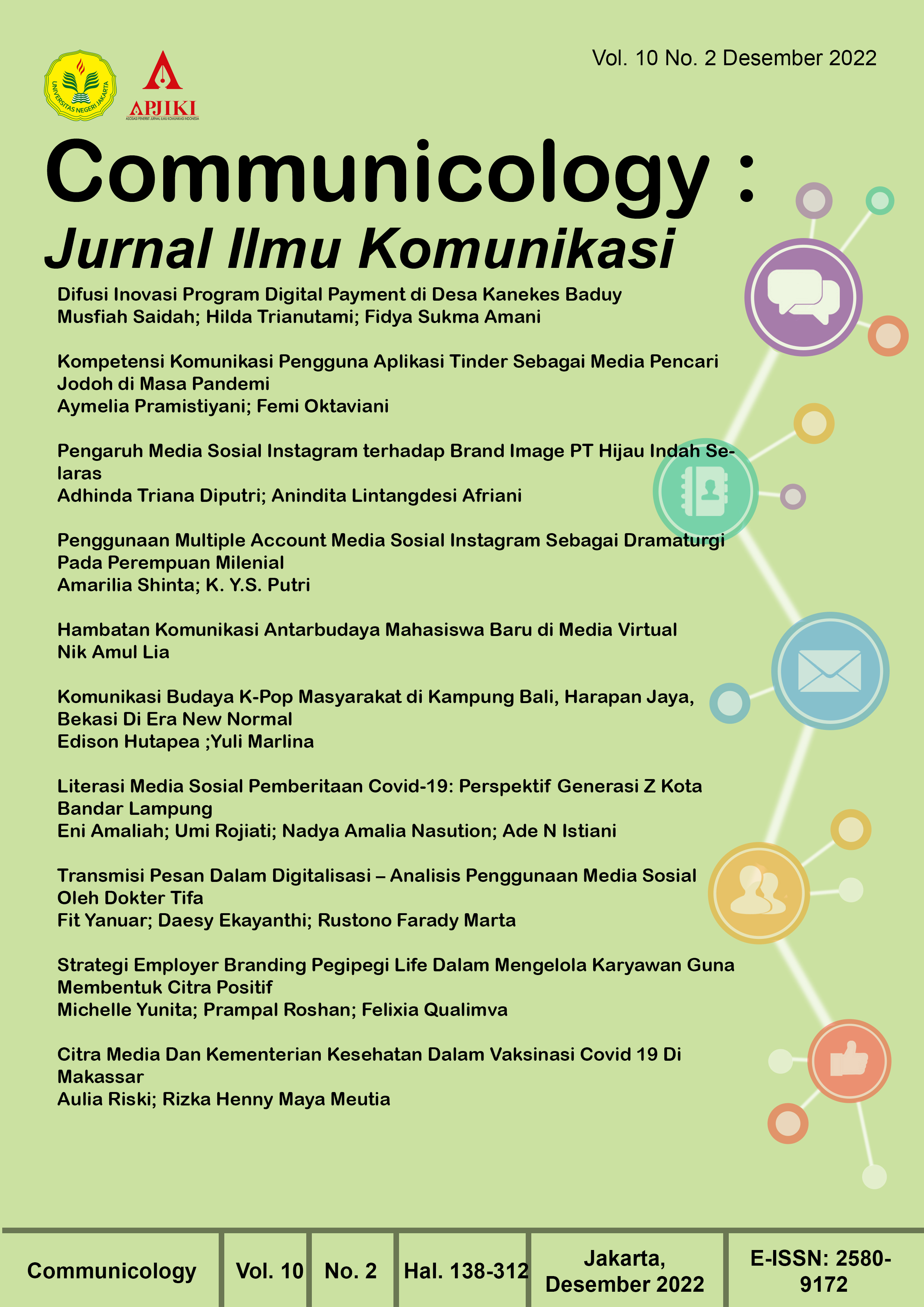Komunikasi Budaya K-Pop Masyarakat di Kampung Bali, Harapan Jaya, Bekasi Di Era New Normal
DOI:
https://doi.org/10.21009/COMMUNICOLOGY.030.06Keywords:
Self-mind, Society and K-Pop CultureAbstract
Popular culture is a pattern of behavior that is preferred by most people. Appearance and style have become more important than morality, so the values of good or bad have been melted and overturned. Signs of the rapid influence of popular culture can be seen on consumptive Indonesian society. This happened due to foreign popular culture makes a person unaware of what is happening at that time. The researcher uses the hypodermic needle theory of communication in this study. Regarding the use of this theory is a process such as a mechanically rotating conveyor belt with clear elements, there are; a) the source (mediator), b) message (communicant), c) channel ( media), d) receiver (audience), and e) feedback (effect). In other words. This research used qualitative research procedure that produces descriptive data in the form of words, written or spoken words of people and observable behavior. By helping of social media, it has resulted in the dissemination of information about Korean culture in society, in this case a lot of people become fans of Korean culture for entertainment or to fill their spare time. Interaction between friends affects are able to spread the Korean culture, the interaction that occurs made people want to know more deeply and created a new sense of curiosity about Korean culture. With the existence of Korean culture, it also helps the community to survive through the crisis period that was occurred during pandemic.
References
Fitrah, Muh, Dkk, 2017, Metodologi Penelitian Kualitaif, Tindakan Kelas dan
Studi, Jawa Barat, CV. Jejak.
Hamdi, Asep Saepul. 2014, Metode Penelitian Kuantitatif Aplikasi dalam Pendidikan,
Yogyakarta, Deepublish
M, Elly. Setiadi dkk. 2007, Ilmu Sosial dan Budaya Dasar Edisi Kedua,
Jakarta : Kencan Prenada Media Grup.
Maryati, Kun. Dkk, 2007, Buku Sosiologi untuk SMA dan MA kelas XI. Jakarta Erlangga.
Nawawi, Hadari. 1993. Metode Penelitian Sosial.Yogyakarta : Gajah Mada
University Press.
Rukajat, Ajat, 2018, Pendekatan Penelitian Kualitaif (Qualitative Research Apporach),
Yogyakarta, CV. Budi Utama.
Rustan, Sultra Ahmad, Dkk, 2017, Pengantar Ilmu Komunikasi, Sleman, CV.Budi Utama.
Satibi, Iwan. 2011. Teknik Penulisan Skripsi, Tesis & Disertasi. Bandung:Ceplas
Soekanto, Soerjono, 1990, Sosiologi SuatuPengantar: Edisi Baru Kempat
1990.Jakarta : PT. Raja Grafindo Persada.
Supriyati. 2011. Metodologi Penelitian.Bandung: Labkat press.
Suwendra, Wayan, Drs, 2018, Medologi Penelitian Ilmu Sosial, Pendidikan,
Kebudayaan, dan Keagamaan, Bali, NilaCakra.
Suyanto, Bagong. 2005. Metode Penelitian Sosial. Jakarata: Kencana
Alvermann, D. E., Hagood, M. C., & Williams, K. B. (2001). Image, Language, and Sound: Making Meaning with Popular Culture Texts. Reading Online, 4(11).
Dewi, D. M., Setyaningsih, I. I., & Romadhon, A. (2022). Impact of Information and Communication Technology on The Welfare of Population in Eastern Indonesia. Proceedings of The International Conference on Data Science and Official Statistics, 2021(1). https://doi.org/10.34123/icdsos.v2021i1.224
Kim, S. M., & Park, M. J. (2020). Evaluation of cross-national global market segmentation and strategy: The case of Korean Wave for ASEAN countries. Asia Pacific Management Review, 25(4). https://doi.org/10.1016/j.apmrv.2020.04.001
Krause, D., & Denzin, N. K. (1989). The Research Act: A Theoretical Introduction to Sociological Methods. Teaching Sociology, 17(4). https://doi.org/10.2307/1318434
Landy, J. F., & Royzman, E. B. (2018). The moral myopia model: Why and how reasoning matters in moral judgment. In The New Reflectionism in Cognitive Psychology: Why Reason Matters. https://doi.org/10.4324/9781315460178
Larasati, D. (2018). Globalization on Culture and Identity: Pengaruh dan Eksistensi Hallyu (Korean-Wave) Versus Westernisasi di Indonesia. Jurnal Hubungan Internasional, 11(1). https://doi.org/10.20473/jhi.v11i1.8749
Nurfalah, Maya, & Widiyanti. (2011). Jurnal Komunikasi Pembangunan. Jurnal Komunikasi Pembangunan, 9(2).
Popular Culture in Indonesia. (2008). In Popular Culture in Indonesia. https://doi.org/10.4324/9780203895627
Putri, I. P., Liany, F. D. P., & Nuraeni, R. (2019). K-Drama dan Penyebaran Korean Wave di Indonesia. ProTVF, 3(1). https://doi.org/10.24198/ptvf.v3i1.20940
Radovic, A., Gmelin, T., Stein, B. D., & Miller, E. (2017). Depressed adolescents’ positive and negative use of social media. Journal of Adolescence, 55. https://doi.org/10.1016/j.adolescence.2016.12.002
Tanliana, D., & Utami, L. S. S. (2022). Perilaku Konsumtif Penggemar Korean Wave di Twitter (Studi Tentang Fenomena Koleksi Photocard K-Pop). Koneksi, 6(1). https://doi.org/10.24912/kn.v6i1.15549
.
Downloads
Published
How to Cite
Issue
Section
License
Authors who publish with this Journal agree to the following terms:
- Author retain copyright and grant the journal right of first publication with the work simultaneously licensed under a creative commons attribution licensethat allow others to share the work within an acknowledgement of the work’s authorship and initial publication of this journal.
- Authors are able to enter into separate, additional contractual arrangementfor the non-exclusive distribution of the journal’s published version of the work (e.g. acknowledgement of its initial publication in this journal).
- Authors are permitted and encouraged to post their work online(e.g. in institutional repositories or on their websites) prior to and during the submission process, as it can lead to productive exchanges, as well as earlier and greater citation of published works.
Users/public use of this website will be licensed to CC BY





